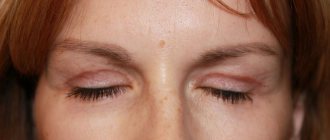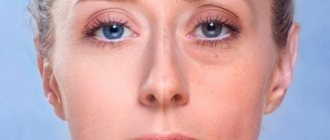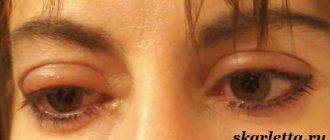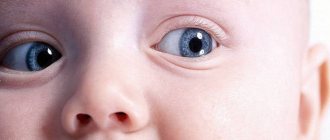Blepharoplasty eliminates hernias and drooping eyelids, makes the eyes open, and the skin tightened. But you can admire the final result only after two months, when the swelling and bruising have passed. Fortunately, the recovery period can be significantly reduced by following simple recommendations.
Features of edema after blepharoplasty of the upper and lower eyelids
During surgery, blood vessels are damaged. This is normal and inevitable. As a result, blood enters the tissues, forming bruises. The body fights the damage and sends large amounts of plasma to protect the blood from infection. This is how swelling appears after blepharoplasty .
The severity of swelling depends on several factors:
- Individual characteristics. With thick skin, swelling is less pronounced, but takes longer to go away.
- Age of patients. In younger patients, in whom tissue regeneration occurs more quickly, recovery will not take much time.
After blepharoplasty of the upper eyelids, swelling is less noticeable, but lasts longer. The skin here is thin and sensitive.
Swelling after lower blepharoplasty extends to the zygomatic part of the face. But they go faster.
The type of access for the operation is important. After laser correction, the blood vessels are restored faster, so bruises and swelling do not linger for a long time. In a skin excision operation, the injured part will take two to three weeks to heal, and full recovery can only be observed by the end of the second month. Although you can go “in public” earlier, and the traces of the operation will not be particularly noticeable.
The rehabilitation period after blepharoplasty
Immediately after surgery, the area that was manipulated is extremely weakened, indicating its sensitivity to the environment. For several days, the maximum risk of various microbes entering wounds that have not yet completely healed remains. Doctors advise refusing cosmetic procedures and even washing in order to prevent infection, as well as to prevent the possibility of increased swelling.
We recommend: What care is needed after upper eyelid blepharoplasty?
If no complications have appeared within 72 hours, washing can be returned to the list of daily procedures, while avoiding getting water into the eyes. Each surgical intervention involves a specific period of rehabilitation of the body. In the case of blepharoplasty, its duration is 14 days. You can speed up this process yourself - to do this you need to strictly follow medical recommendations:
- say no to bad habits. Not ready to make radical changes and eliminate smoking and alcohol from your daily life? Give them up during rehabilitation;
- peace – emotional and physical. Avoid strenuous exercise and sports during the first and second days - you still need to go to bed;
- Even rapid head movements are contraindicated. Downward bends easily cause an increase in eye pressure, and this has negative consequences after blepharoplasty. A universal solution is to ask relatives to help with household chores;
- various stresses and psychological tensions become enemy number one;
- you need to put the books back on the shelf, and instead choose to listen to audiobooks or music;
- To protect your eyes from infection, you need to forget about water procedures for a while - hot baths and trips to the bathhouse, sauna. A short warm shower would be appropriate.
Since we are talking about eye surgery, they become extremely vulnerable and susceptible. Glasses with UV protection will be indispensable in this situation (just don’t buy cheap glasses from unknown manufacturers, no matter how beautiful they are - they can easily cause severe retinal burns), and giving up the computer and TV will give your eyes the necessary two-week rest . You do not need to wear contact lenses for two weeks.
Any self-medication during recovery is completely excluded. Accurately following the doctor's instructions is your duty and responsibility. Even the use of medicinal ointment or cream requires prior approval from the doctor.
The last recommendation, no less important, is extremely simple - introducing a healthy lifestyle. Everyone knows about it, but they don’t yet fully understand what this phrase actually means. The rehabilitation period after blepharoplasty creates ideal conditions for joining the cult of health.
Healthy sleep is very important during the rehabilitation period after blepharoplasty.
It is impossible to imagine a healthy lifestyle without sound, healthy sleep, and during the rehabilitation period the use of high pillows is encouraged, which helps eliminate swelling. And, of course, proper nutrition, which eliminates the possibility of disrupting the proper functioning of the stomach and intestines.
We recommend: How long does upper eyelid blepharoplasty take to heal?
Among the unpleasant consequences of the operation, one can note swelling of the eyes, which occurs due to water-salt imbalance. To avoid this trouble, you need to avoid eating too salty, spicy and fatty foods during recovery. You also need to give up coffee and switch to broths made with lean meats. Such food helps maintain strength and is also easily absorbed by the human body.
For quick recovery, you need to follow a daily schedule and sleep schedule - its duration should be the traditional 8 hours, and you need to go to bed before 0:00.
It takes more than a week to remove the stitches (if the healing process is positive); even less time will be required if the operation was performed on the upper eyelids. As for the complete removal of swelling, as well as redness of the eyes, this will take from 1 to 1.5 months, and in personal situations – even more time. After this period, visual changes can be assessed.
When starting further preventive actions, you need to remember that:
- After about 7 days, you can use face masks, but avoid applying them to the area of stitches and eyes. At the same time, massage should be added to the skin restoration plan, but it must be entrusted to real specialists in this area;
- decorative cosmetics often lead to irritation of the eyelids, so applying makeup is canceled for 2 weeks; you should also forget about scrubs and cleansing lotions for a month - their use depends on the speed of healing;
- complex cosmetic procedures are also questionable. Due to the aggressive impact, they cannot be done earlier than two months from the date of surgery.
How long do bruises and swelling last after blepharoplasty?
Swelling under the eyes and on the upper eyelids is noticeable for at least a week. After transconjunctival plastic surgery, bruises disappear in four days, after classical surgery - in a week and a half. But these are relative indicators. In each specific case, only a doctor will tell you when the swelling will subside, based on various factors:
- Patient's age. The older the person, the slower the tissue regeneration and, accordingly, the longer the recovery takes.
- Skin structure. On thick epidermis, swelling is less noticeable and there are not as many bruises as on thin epidermis, but recovery is slower.
- Blood circulation level. If the process is slow, it will not be possible to quickly remove bruises and swelling.
- Access method. After the transconjunctival sutureless procedure, swelling disappears completely within a week. After four days they become almost invisible.
- Site of invasion. Swelling after upper blepharoplasty disappears faster because the skin on the eyelids is thin. But it shows hematomas much more clearly.
- Infection. If during surgery or due to improper care bacteria penetrate into the inner layers of the epidermis, healing will be long and will not take place without taking antibiotics. In some cases, repeat surgery may be required.
In one eye, swelling may be more pronounced and last longer. This depends on individual characteristics due to the asymmetry of the capillaries. Infestation can also be different. If your eyelids swell unevenly after blepharoplasty, this may mean that more skin has been removed from one side.
How long will it take for scars to heal?
After blepharoplasty, the patient is usually sent home after 3-5 hours. This is allowed only if there are no complications. The next day after surgery, pain, swelling, bruises and redness in the eye area may appear. Such symptoms are normal and occur due to damage to nerves and blood vessels. To eliminate discomfort, it is recommended to apply cold compresses to the affected areas.
Removal of postoperative sutures is performed on days 5-6, but swelling and bruising may remain for another two weeks. Keloid scars after blepharoplasty take a long time to heal. This happens in several phases:
- Exudative stage. Its duration is 6-8 days. This phase is considered inflammatory, since the eyelids remain red and swelling is observed. During this period, it is recommended to adhere to the rules of seam hygiene. Physical activity is not allowed, as it will lead to the sutures coming apart and causing bleeding. It is also important not to strain your eyes at this stage.
- Granulation of seams. This period is observed for the first 7-14 days after surgical procedures. At the site of the scar, new tissue appears, elastin and collagen fibers are formed. Scars are usually pink in color.
- Scar formation. Scars appear 30-90 days after eyelid surgery. The seam structure becomes more dense. The scar tissue is lightened and smoothed out. This stage is the most important, since if all rehabilitation rules are not followed, hypertrophic or keloid scars will occur.
- The scar fully matures 4-9 months after eyelid surgery. The scar thickens, turns white, evens out, and becomes invisible.
If all medical recommendations are followed, scar healing occurs painlessly for the patient and unnoticed by others.
The location of the scars depends on the type of lift. After plastic surgery of the lower eyelids, they are formed along the visual organ under the ciliary edge. With complete regeneration, they are no different from the structure of normal epithelium. The transconjunctival technique allows you to hide scars, since the incisions are made from the inside. With upper eyelid surgery, the scars are located in the crease above the eyes; they become invisible 14 days after the operation.
You can learn more about scars after blepharoplasty from the video:
How to relieve swelling after blepharoplasty with medications
Swelling and hematoma after surgery only increase in the first two days. At the same time, the eyelids itch because the incision line is healing. To prevent tissue infection, the doctor prescribes antibiotics. To eliminate discomfort associated with itching, bruising and swelling - ointments: Hydrocortisone, Lokoid, Liaton, Traumeel, Sinyakoff. The main thing is that the patient is not allergic to the components of the medications, otherwise the swelling will become even worse.
Ointment for bruises should be applied once or twice a day, without stretching the skin of the eyelids and without getting on the mucous membrane. The course of treatment is one week.
Additionally, from the first day you can take Traumeel tablets for puffiness under the eyes after blepharoplasty. They consist of plant components and have a diverse effect, significantly improving the condition.
Features of care after blepharoplasty
The speed of recovery after surgery directly depends on the quality and regularity of care for the area that has undergone plastic surgery. This is a complex of different measures that affects the skin area (including postoperative sutures) and the eyes. Let's go through them in more detail:
- seams. In the first days, you need to wear a sterile bandage that will protect the stitches from infection. The doctor prescribes the use of antiseptics, creams and ointments, the use of which helps to quickly tighten the stitches. Particularly popular is Levomekol ointment, which successfully protects against suppuration, and Lyoton should be applied to the lower eyelids for 1 week. Redness on the skin that remains after the doctor removes the stitches completely disappears thanks to the use of absorbable gel or eyelid cream after blepharoplasty;
- eyes. In the first time after surgery, they are quite inflamed, swelling occurs - therefore, wearing lenses that create additional irritation and pressure is excluded. To get rid of inflammation and dryness, the doctor prescribes special drops;
- lower and upper eyelid. Eyelid skin care provides three main functions:
- protects against germs (use of a special patch during the first 72 hours);
- relieves swelling (cold compresses are needed to quickly eliminate swelling);
- stimulates the healing process (doctors often recommend using a cream based on Chinese mushroom extract, it should be applied 2 times a day, and the course of therapy is 2 weeks. During this time, you need to keep in mind that you cannot prescribe remedies for yourself!
We recommend: When are sutures removed after blepharoplasty?
A useful addition to the doctor’s medical prescriptions is to include a set of therapeutic exercises in the list of postoperative care measures: they stabilize blood circulation in the area that has been subjected to surgery and help eliminate swelling and inflammation.
Gymnastics for the eyes
Traditional recipes for swelling after blepharoplasty
Herbal preparations are famous for their anti-inflammatory and disinfecting effects. relieve swelling and bruises after blepharoplasty . Sterile cotton pads should be dipped in the strained liquid, squeezed lightly and applied to the eyes for 15 minutes. Do the procedure 3 times a day.
It is better to prepare an infusion from one component to observe the skin reaction. Herbs can trigger allergies, which can cause increased itching.
You can use grated raw potatoes or finely chopped parsley as an applicator.
Since the body's reaction to the components may vary, an ophthalmologist's approval should be obtained for the procedure.
How to remove scars after blepharoplasty using traditional methods?
If after blepharoplasty there are long scars, and you are not ready for radical methods, you can use the traditional methods presented in the table:
| Product name | Cooking method |
| Herbal collection | Take dry chamomile, nettle leaves, yarrow, calendula, St. John's wort in equal parts. Pour water (250 ml of boiling water) over the herbs and leave in a heat bath for 65 minutes. After this, the composition is filtered. A piece of linen cloth is soaked in the prepared preparation and applied to the scars. The lotion is kept for 2 hours. |
| Wax-olive mixture | Olive oil (220 ml) is poured into a pan, 50 g of high-quality beeswax is added. The mixture is placed on low heat for 10-12 minutes. After this, the composition is cooled, a linen or cotton napkin is soaked in it, and applied to the scars. The procedure is carried out at least twice a day for 60 days. |
| Parsley tincture | Chop the parsley and pour boiling water (1 cup). The product is left for 15 minutes, then the composition is frozen, divided into small portions. Ice cubes are used to wipe the scar twice a day. Duration of therapy is 3 months. |
| Marshmallow tincture | Finely chop 15 g of marshmallow root, add 250 ml of cold water and leave for 5-7 hours. After the specified time, use the infusion to treat scars every 3-4 hours. In the absence of marshmallow, it is replaced with mint or lemon balm. |
| Melon mask | Take 12-20 melon seeds, 2 eggshells, 5 ml of olive oil. The seeds are dried, crushed, then all components are mixed. The prepared mask is applied to the scar and wrapped with a bandage. The course of treatment is 1 month. |
It is recommended to use traditional medicine only after consulting a doctor. They do not guarantee a quick result, but after a course of treatment they can reduce the appearance of scars.
Cosmetical tools
Non-medical creams should only be used after injured tissue has healed. The action of cosmetics is based on improving tissue regeneration and skin cell renewal.
Cream with retinol is good for removing puffiness under the eyes. Creams with lingzhi and shiitake mushroom extract have a high restorative ability. But you can use cosmetics only after approval from your doctor.
Heparin ointment
The drug has many indications. The drug is used in the treatment of thrombophlebitis, injuries and bruises. Prescribed for external use. The medicine is effective against bruises and is used for bags under the eyes. The product has repeatedly proven its effectiveness. The medicine is available in the form of an ointment for external use in aluminum tubes of 10 g and 25 g.
It has a jelly-like consistency of a white-yellowish hue.
Compound
The drug contains 3 active components:
- Heparin. The mechanism is based on binding to antithrombin III. As a result of this interaction, the binding of antithrombin to blood coagulation factors is enhanced and their enzymatic activity is blocked. This substance increases blood flow.
- Benzocaine. A local anesthetic reduces the permeability of the cell membrane to ions. Benzocaine blocks the occurrence and conduction of nerve impulses. When applied topically, absorption is minimal.
- Benzyl nicotinate dilates capillaries, restores blood circulation and improves the penetration of heparin into tissues.
The ointment uses auxiliary components. These are glycerin, water, emulsifier No. 1, petroleum jelly, peach oil (improves skin tone and makes it elastic), stearic acid and propyl parahydroxybenzoate.
Excipients do not take part in the therapeutic effect. The role of these components is to maintain the structure of the drug.
Effective against puffiness under the eyes
Heparin ointment dilates capillaries and accelerates microcirculation in the periorbital area. The medicine normalizes metabolic processes without the introduction of chemicals. Since the cause of swelling and dark circles is the formation and stagnation of blood clots, this medicine is a real salvation.
Heparin ointment is well tolerated by patients and quickly improves skin condition. Gets rid of dark circles under the eyes after the first use. The face becomes fresher and more toned.
The effectiveness of the drug for minor swelling appears after a day of use. With severe swelling, improvement occurs after 3 days. The swelling subsides gradually; you should not expect an instant result if the symptom is severe.
The anesthetic included in the composition reduces the severity of pain when swelling develops as a result of injury. The drug has a local analgesic effect.
With regular use of the drug, it will be possible to stop the aging process.
Mode of application
Before using the drug for cosmetic purposes to eliminate swelling, you will need to check the skin's reaction to the active substance. A small area on the forearm or wrist is treated with the drug. During the day, monitor the condition of the epidermis. If redness, itching or rash appears, the medicine should not be used for cosmetic purposes.
Mode of application:
- cleanse the skin of cosmetics and fat;
- wipe dry;
- Apply a thin layer 2 times per day.
There is no need to wash off the drug.
Side effects and interactions with other drugs
Long-term use of the medication leads to adverse reactions. The allergy manifests itself as a skin rash, redness of the periorbital area, which gradually spreads to the rest of the face. Angioedema is also possible - this is swelling of the deep layers of the dermis and subcutaneous tissue.
Other side effects:
- hemorrhages - bleeding of the mucous membranes, occurs as a result of changes in one or more parts of hemostasis;
- small pustules of vesicles or blisters;
- burning;
- itching
The effect of the drug is enhanced by anticoagulants and other non-steroidal anti-inflammatory drugs. When using Heparin ointment simultaneously with tetracyclines, nicotine and antihistamines, the effect of the former is weakened.
Contraindications
The medication is not used for allergic reactions to heparin, benzocaine and benzyl nicotinate. It is these components that can lead to severe allergies. Heparin ointment is contraindicated in the following cases:
- intolerance to additional components of the drug;
- violation of the integrity of the skin in the area of application of the cream;
- infected wounds or ulcerative-necrotic processes;
- impaired blood clotting;
- decreased platelet count;
- the presence of a form of thrombocytopenia caused by the use of heparin, which is used in clinical practice for the purpose of therapy and prevention of thrombosis.
Safety of use in pregnant women is unknown. The active ingredient does not cross the placental barrier and is not excreted in breast milk, but there is little information about the ability of other substances to penetrate into the baby.
Therefore, the use of the medication during pregnancy and breastfeeding is permitted only in emergency situations, if the potential risk for the baby is less than the benefit for the expectant mother.
Overdose
The Ministry of Health has not received any information about an overdose of this drug. The active substance has a low level of absorption into the blood, so the likelihood of an overdose of Heparin ointment is extremely low.
Additional recommendations
After blepharoplasty, bruises under the eyes will go away faster if all the conditions of the rehabilitation period are met:
- sleep only on your back with pillows raised high;
- do not lower your head down, even tilt it back when washing;
- do not watch TV, do not read;
- protect your eyes from bright light with dark glasses;
- try to blink less;
- do not drink alcohol, stop smoking if possible;
- Salt dishes less, eliminate hot seasonings;
- drink 1.5 liters of water per day;
- do not perform physical activity;
- apply cold compresses on the first day;
- Do not touch your eyes with your hands, except for mandatory procedures.
Removing stitches after blepharoplasty
Every patient is interested in the question: if the eyes were operated on after blepharoplasty, then how long after the sutures are removed? The tightening time may vary. On average, stitches last from two days to a week. The wearing period is influenced by factors such as:
- patient's age;
- general health;
- skin elasticity;
- smoking;
- drinking alcoholic beverages.
The process of removing stitches after blepharoplasty is almost painless. The seam is placed inside the skin, that is, the stitches are not visible from above. The ends of the thread are secured on the outer and inner corners of the eye with a special plaster - a strip. At the time of removal of the connecting threads, the most painless period is considered to be peeling off the patch.
We recommend: When are sutures removed after blepharoplasty?
The skin of the eyelids itself is delicate, and in the postoperative period the sensitivity increases. After removing the patch, the end of the thread at the inner corner of the eye is cut short, and the surgeon takes out the thread using the long end at the outer corner. At first there is a slight resistance, but then the thread comes out easily. Upper blepharoplasty sutures are removed less painfully than lower blepharoplasty.
Scheme of the operation
After performing blepharoplasty, the surgeon must inform the patient on the day the sutures will be removed. Usually this procedure is done 5 days from the day of surgery. The length of time the sutures are worn depends on the patient’s age, the fullness and general turgor of the facial skin. Patients over 50 years of age, especially those with a full face, need to wear stitches for 4-5 days. For patients under 40 years of age, the doctor prescribes a removal procedure on the third day.
The process of removing sutures after blepharoplasty is greatly simplified by absorbable threads, which disappear by dissolving into the patient’s tissues. It is placed on an intradermal suture, which makes the tissue junction invisible after the swelling goes away.
The main thing is to understand that it will take about 12-16 weeks for the stitches after blepharoplasty to completely heal and the skin to restore. After removal of the fixation, swelling, wrinkled skin, swelling, and bruising may appear. This is a normal phenomenon, thus the body reacts to the operation. A slightly red seam after blepharoplasty is also normal.
If bruises and swelling do not go away after blepharoplasty
Prolonged healing and pronounced signs of surgery require diagnosis. If swelling does not go away for a long time after plastic surgery, you should go for an unscheduled examination. Depending on the general condition, the doctor will prescribe one of the methods:
- In the absence of serious complications, use medications and cosmetics. After some time, the swelling goes away on its own.
- For severe headaches and blurred vision, you may need to take medications in combination with physical therapy.
- If the hematoma does not resolve for a long time, the surgeon spreads the edges of the incision and removes the blood clot. The vessel may need to be sutured.
The most dangerous thing is that after blepharoplasty, prolonged swelling may indicate such serious consequences as:
- Infections. Tissue infection can begin during surgery if sterility is not maintained or during rehabilitation, which is more likely. The infection causes redness of the skin and additional swelling. The doctor decides how to remove it individually. In most cases, antibiotic therapy and antiseptic treatment are prescribed.
- Inverted eye effect. Occurs due to excessive removal of skin on the lower eyelid. In this case, a massage, additional sutures or repeated surgery may be prescribed.
- Retrobulbar hematoma. A complication occurs if a large vessel is affected and blood clots appear behind the retina. In this case, redness and persistent swelling are accompanied by pain when rotating the eye sockets. An additional operation solves the problem.
If you respond correctly to your condition and follow general recommendations, swelling will go away quickly. Blepharoplasty is not a complex operation and rarely causes complications.
How to speed up the healing of scars and hematomas during recovery after blepharoplasty?
After blepharoplasty, bruises appear due to impaired blood circulation in small capillaries and the accumulation of corresponding fluid. This is a natural microphysiological reaction of the body when damaged. But a long-term state of swelling aggravates blood circulation due to the pressure exerted on the walls of microvessels, preventing the rapid tightening of sutures and wounds. Bruises can be reduced with the help of medications, cosmetics and folk remedies.
Scars heal on their own and do not require special treatment. After a month, they turn into a thin, barely visible strip. Mesotherapy, which is carried out after plastic surgery, makes scars invisible.
Medicines – Lokoid, Lyoton – are the most frequently prescribed decongestants by doctors. The method of their work is to restore skin receptors, reduce permeability and increase vascular resistance.
They prevent the formation of blood clots and eliminate inflammation. Lyoton-gel also has an analgesic effect. Such drugs are extremely effective in upper eyelid blepharoplasty. Cosmetic preparations (gel with retinol, gel with caffeine, cream with Chinese mushroom extract) - like all dietary supplements, are not medicines.
They improve the general condition of the skin and metabolic processes in the area of application. Folk remedies - chamomile, parsley, linden, sage - are used in the form of compresses and improve the condition due to a mild anti-inflammatory and antiseptic effect.
The use of any means is possible only after consultation and discussion with a doctor.
Throughout the entire rehabilitation period, you need to pay attention to special exercises. They are aimed at restoring the functioning of the eyelids and additionally increase blood supply to the skin, returning lost tone to the eye muscles. All techniques are very simple and do not require special training.
YouTube responded with an error: The request cannot be completed because you have exceeded your quota.
Rate this article:
- Related Posts
- When can you wear makeup after blepharoplasty?
- How long does upper eyelid blepharoplasty take to heal?
- When can you get a tattoo after blepharoplasty?
- How to do facial massage after blepharoplasty?
- When can you drink alcohol after blepharoplasty?
- What eye drops are needed after blepharoplasty?
Answers on questions
Is it possible to have blepharoplasty after Botox?
It is possible, the procedures are quite compatible, but it is advisable that 6 months pass after the botulinum toxin injections. Only in this case will the surgeon be able to objectively assess how much and where to remove excess skin.
What to do if your eyes are different after blepharoplasty?
The situation when one eye is narrower and the other wider is not uncommon. If the cause of asymmetry is swelling, wait until it goes down. In some cases, fluid accumulation can take up to 6 months to resolve. It is much worse if the difference appeared due to the doctor’s fault. In this case, a second operation will most likely be required.
When can you wear makeup after blepharoplasty?
Makeup and any creams should not be applied to injured areas for at least 2 weeks. If rehabilitation occurs with complications, it is better to wait until the eyes are completely healed. Then it is advisable to use hypoallergenic cosmetics for sensitive skin.
When can you exercise after blepharoplasty?
Within 7 days after blepharoplasty you can return to normal life, but it is recommended to go to the gym or go jogging no earlier than 2 weeks later. This is due to the load on the vessels and pressure fluctuations, which affect the healing rate.
What to do if after blepharoplasty the lower eyelid moves away from the eye?
Unfortunately, such a complication requires surgical correction. It is impossible to cope with eversion of the eyelid with conservative therapy. Therefore, contact the doctor who performed the previous operation or find another, more experienced one.
How to sleep after blepharoplasty?
To prevent excess fluid from accumulating in the eye area, sleep on your back for the first 3 days, placing a high pillow under your head. In the next month, try not to lie on your stomach with your face down. It is desirable that sleep during the recovery period be sound and complete.










